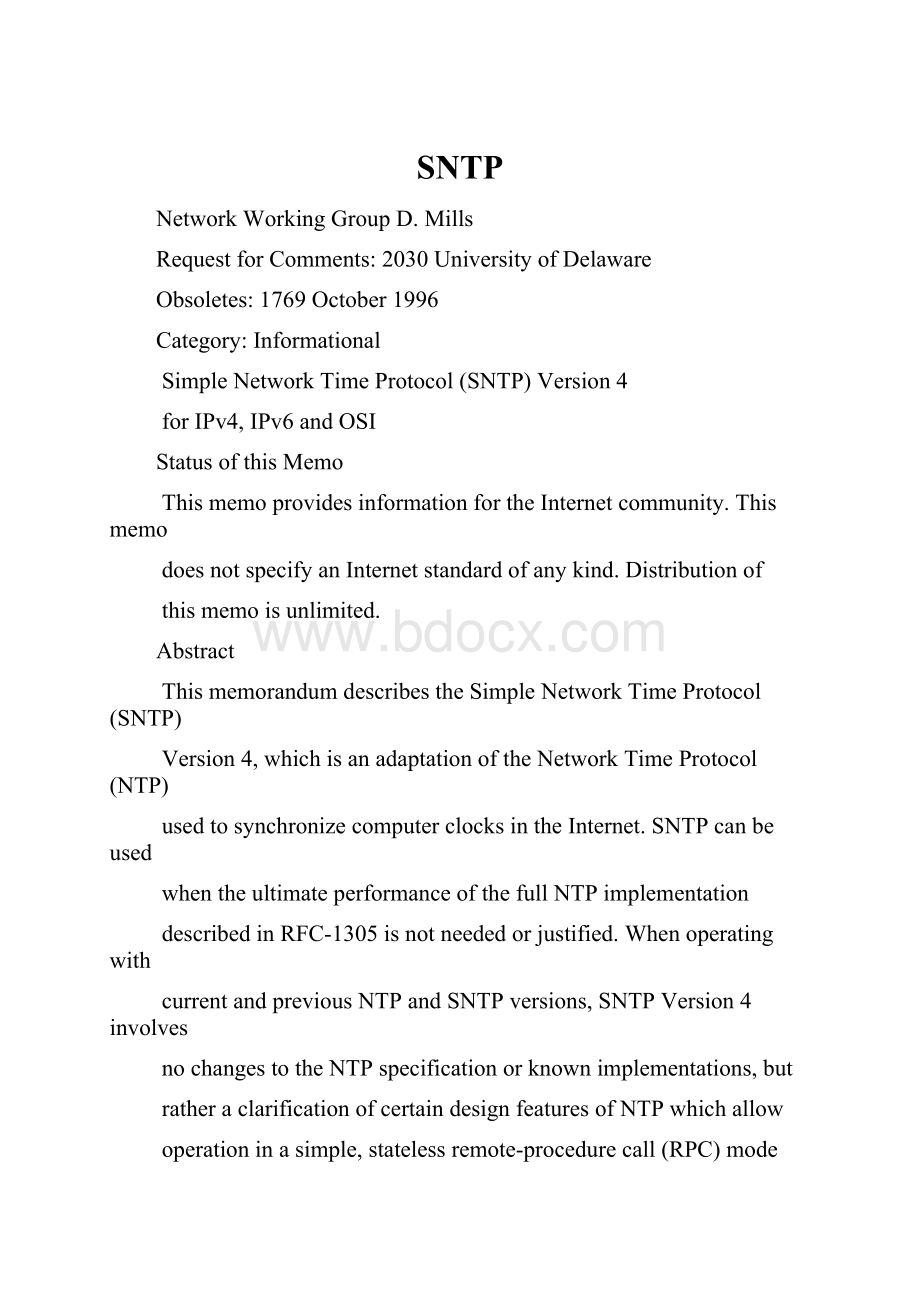SNTP.docx
《SNTP.docx》由会员分享,可在线阅读,更多相关《SNTP.docx(31页珍藏版)》请在冰豆网上搜索。

SNTP
NetworkWorkingGroupD.Mills
RequestforComments:
2030UniversityofDelaware
Obsoletes:
1769October1996
Category:
Informational
SimpleNetworkTimeProtocol(SNTP)Version4
forIPv4,IPv6andOSI
StatusofthisMemo
ThismemoprovidesinformationfortheInternetcommunity.Thismemo
doesnotspecifyanInternetstandardofanykind.Distributionof
thismemoisunlimited.
Abstract
ThismemorandumdescribestheSimpleNetworkTimeProtocol(SNTP)
Version4,whichisanadaptationoftheNetworkTimeProtocol(NTP)
usedtosynchronizecomputerclocksintheInternet.SNTPcanbeused
whentheultimateperformanceofthefullNTPimplementation
describedinRFC-1305isnotneededorjustified.Whenoperatingwith
currentandpreviousNTPandSNTPversions,SNTPVersion4involves
nochangestotheNTPspecificationorknownimplementations,but
ratheraclarificationofcertaindesignfeaturesofNTPwhichallow
operationinasimple,statelessremote-procedurecall(RPC)mode
withaccuracyandreliabilityexpectationssimilartotheUDP/TIME
protocoldescribedinRFC-868.
TheonlysignificantprotocolchangeinSNTPVersion4overprevious
versionsofNTPandSNTPisamodifiedheaderinterpretationto
accommodateInternetProtocolVersion6(IPv6)[DEE96]andOSI
[COL94]addressing.However,SNTPVersion4includescertainoptional
extensionstothebasicVersion3model,includingananycastmode
andanauthenticationschemedesignedspecificallyformulticastand
anycastmodes.Whiletheanycastmodeextensionisdescribedinthis
document,theauthenticationschemeextensionwillbedescribedin
anotherdocumenttobepublishedlater.Untilsuchtimethata
definitivespecificationispublished,theseextensionsshouldbe
consideredprovisional.
ThismemorandumobsoletesRFC-1769,whichdescribesSNTPVersion3.
Itspurposeistocorrectcertaininconsistenciesintheprevious
documentandtoclarifyheaderformatsandprotocoloperationsfor
currentNTPVersion3(IPv4)andproposedNTPVersion4(IPv6and
OSI),whicharealsousedforSNTP.AworkingknowledgeoftheNTP
Version3specificationRFC-1305isnotrequiredforan
implementationofSNTP.
MillsInformational[Page1]
RFC2030SNTPv4forIPv4,IPv6andOSIOctober1996
1.Introduction
TheNetworkTimeProtocol(NTP)Version3specifiedinRFC-1305
[MIL92]iswidelyusedtosynchronizecomputerclocksintheglobal
Internet.Itprovidescomprehensivemechanismstoaccessnational
timeandfrequencydisseminationservices,organizethetime-
synchronizationsubnetandadjustthelocalclockineach
participatingsubnetpeer.InmostplacesoftheInternetoftoday,
NTPprovidesaccuraciesof1-50ms,dependingonthecharacteristics
ofthesynchronizationsourceandnetworkpaths.
RFC-1305specifiestheNTPVersion3protocolmachineintermsof
events,states,transitionfunctionsandactionsand,inaddition,
engineeredalgorithmstoimprovethetimekeepingqualityandmitigate
amongseveralsynchronizationsources,someofwhichmaybefaulty.
Toachieveaccuraciesinthelowmillisecondsoverpathsspanning
majorportionsoftheInternetoftoday,theseintricatealgorithms,
ortheirfunctionalequivalents,arenecessary.However,inmany
casesaccuraciesintheorderofsignificantfractionsofasecond
areacceptable.Insuchcases,simplerprotocolssuchastheTime
Protocol[POS83],havebeenusedforthispurpose.Theseprotocols
usuallyinvolveanRPCexchangewheretheclientrequeststhetimeof
dayandtheserverreturnsitinsecondspastsomeknownreference
epoch.
NTPisdesignedforusebyclientsandserverswithawiderangeof
capabilitiesandoverawiderangeofnetworkdelaysandjitter
characteristics.MostusersoftheInternetNTPsynchronization
subnetoftodayuseasoftwarepackageincludingthefullsuiteof
NTPoptionsandalgorithms,whicharerelativelycomplex,real-time
applications(seehttp:
//www.eecis.udel.edu/~ntp).Whilethesoftware
hasbeenportedtoawidevarietyofhardwareplatformsrangingfrom
personalcomputerstosupercomputers,itssheersizeandcomplexity
isnotappropriateformanyapplications.Accordingly,itisuseful
toexplorealternativeaccessstrategiesusingsimplersoftware
appropriateforlessstringentaccuracyexpectations.
ThisdocumentdescribestheSimpleNetworkTimeProtocol(SNTP)
Version4,whichisasimplifiedaccessstrategyforserversand
clientsusingNTPVersion3asnowspecifiedanddeployedinthe
Internet,aswellasNTPVersion4nowunderdevelopment.Theaccess
paradigmisidenticaltotheUDP/TIMEProtocoland,infact,it
shouldbeeasilypossibletoadaptaUDP/TIMEclientimplementation,
sayforapersonalcomputer,tooperateusingSNTP.Moreover,SNTPis
alsodesignedtooperateinadedicatedserverconfiguration
includinganintegratedradioclock.Withcarefuldesignandcontrol
ofthevariouslatenciesinthesystem,whichispracticalina
dedicateddesign,itispossibletodelivertimeaccuratetothe
MillsInformational[Page2]
RFC2030SNTPv4forIPv4,IPv6andOSIOctober1996
orderofmicroseconds.
SNTPVersion4isdesignedtocoexistwithexistingNTPandSNTP
Version3clientsandservers,aswellasproposedVersion4clients
andservers.WhenoperatingwithcurrentandpreviousversionsofNTP
andSNTP,SNTPVersion4requiresnochangestotheprotocolor
implementationsnowrunningorlikelytobeimplementedspecifically
forNTPirSNTPVersion4.ToaNTPorSNTPserver,NTPandSNTP
clientsareundistinguishable;toaNTPorSNTPclient,NTPandSNTP
serversareundistinguishable.LikeNTPserversoperatinginnon-
symmetricmodes,SNTPserversarestatelessandcansupportlarge
numbersofclients;however,unlikemostNTPclients,SNTPclients
normallyoperatewithonlyasingleserver.NTPandSNTPVersion3
serverscanoperateinunicastandmulticastmodes.Inaddition,SNTP
Version4clientsandserverscanimplementextensionstooperatein
anycastmode.
ItisstronglyrecommendedthatSNTPbeusedonlyattheextremities
ofthesynchronizationsubnet.SNTPclientsshouldoperateonlyat
theleaves(higheststratum)ofthesubnetandinconfigurations
wherenoNTPorSNTPclientisdependentonanotherSNTPclientfor
synchronization.SNTPserversshouldoperateonlyattheroot
(stratum1)ofthesubnetandthenonlyinconfigurationswhereno
othersourceofsynchronizationotherthanareliableradioormodem
timeserviceisavailable.Thefulldegreeofreliabilityordinarily
expectedofprimaryserversispossibleonlyusingtheredundant
sources,diversesubnetpathsandcraftedalgorithmsofafullNTP
implementation.Thisextendstotheprimarysourceofsynchronization
itselfintheformofmultipleradioormodemsourcesandbackup
pathstootherprimaryserversshouldallsourcesfailorthe
majoritydeliverincorrecttime.Therefore,theuseofSNTPrather
thanNTPinprimaryserversshouldbecarefullyconsidered.
Animportantprovisioninthisdocumentisthereinterpretationof
certainNTPVersino4headerfieldswhichprovideforIPv6andOSI
addressingandoptionalanycastextensionsdesignedspecificallyfor
multicastservice.Theseadditionsareinconjunctionwiththe
proposedNTPVersion4specification,whichwillappearasaseparate
document.TheonlydifferencebetweenthecurrentNTPVersion3and
proposedNTPVersion4headerformatsistheinterpretationofthe
four-octetReferenceIdentifierfield,whichisusedprimarilyto
detectandavoidsynchronizationloops.InVersion3andVersion4
primary(stratum-1)servers,thisfieldcontainsthefour-character
ASCIIreferenceidentifierdefinedlaterinthisdocument.InVersion
3secondaryserversandclients,itcontainsthe32-bitIPv4address
ofthesynchronizationsource.InVersion4secondaryserversand
clients,itcontainstheloworder32bitsofthelasttransmit
timestampreceivedfromthesynchronizationsource.
MillsInformational[Page3]
RFC2030SNTPv4forIPv4,IPv6andOSIOctober1996
InthecaseofOSI,theConnectionlessTransportService(CLTS)is
used[ISO86].EachSNTPpacketistransmittedasthtTS-Userdata
parameterofaT-UNITDATARequestprimitive.Alternately,theheader
canbeencapsulatedinaTPDUwhichitselfistransportedusingUDP
[DOB91].ItisnotadvisedthatNTPbeoperatedattheupperlayers
oftheOSIstack,suchasmightbeinferredfrom[FUR94],asthis
couldseriouslydegradeaccuracy.Withtheheaderformatsdefinedin
thisdocument,itisinprinciplepossibletointerworkbetween
serversandclientsofoneprotocolfamilyandanother,althoughthe
practicaldifficultiesmaymakethisinadvisable.
Inthefollowing,indentedparagraphssuchasthisonecontain
informationnotrequiredbytheformalprotocolspecification,but
consideredgoodpracticeinprotocolimplementations.
2.OperatingModesandAddressing
SNTPVersion4canoperateineitherunicast(pointtopoint),
multicast(pointtomultipoint)oranycast(multipointtopoint)
modes.Aunicastclientsendsarequesttoadesignatedserveratits
unicastaddressandexpectsareplyfromwhichitcandeterminethe
timeand,optionally,theroundtripdelayandlocalclockoffset
relativetotheserver.Amulticastserverperiodicallysendsa
unsolicitedmessagetoadesignatedIPv4orIPv6localbroadcast
addressormulticastgroupaddressandordinarilyexpectsnorequests
fromclients.Amulticastclientlistensonthisaddressand
ordinarilysendsnorequests.Ananycastclientsendsarequesttoa
designatedIPv4orIPv6localb